Exploring Bulk Crystal Rocks: Properties and Uses
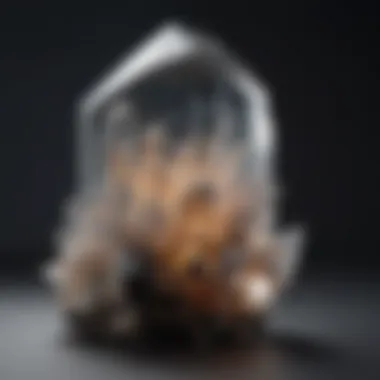
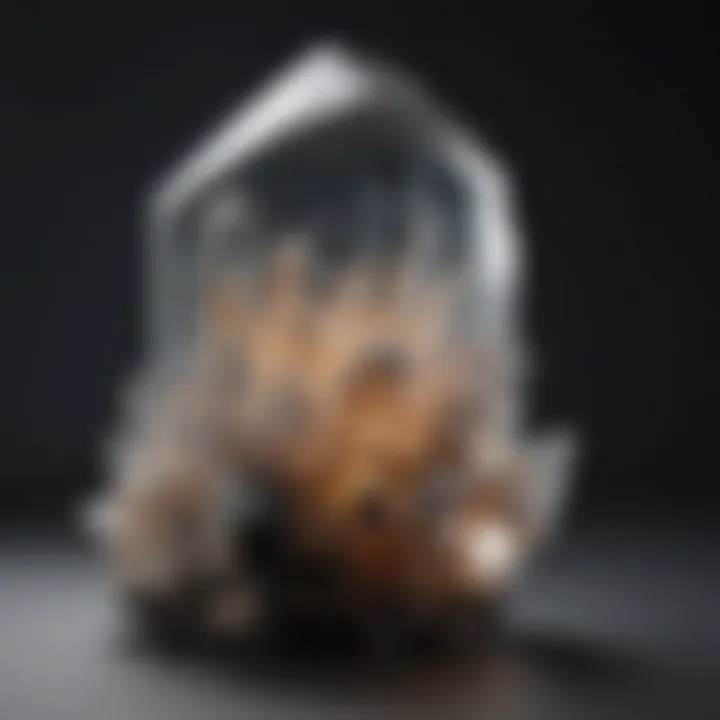
Intro
Bulk crystal rocks represent not just diversities in form and color, but also deep narratives of our planet’s history and its physical processes. These fascinating minerals are more than mere geological trophies; they are windows into the Earth’s past, showing us how forces like heat, pressure, and time shape natural wonders. From the glimmering quartz that catches the eye to the robust jades that carry stories of ancient cultures, understanding these entities opens a gateway to a world where science and art intertwine.
Collectors, both novice and expert, navigate a thrilling journey through the landscapes of geology, all while hunting for that unique specimen to add to their trove. However, beyond the hunt, an encompassing comprehension of the properties, classifications, and uses of bulk crystal rocks enriches this endeavor. Collecting is not just an activity; it's an exploration of nature's wonders.
Through this article, we'll dissect the essence of bulk crystal rocks - their characteristics, the extraordinary uses they hold, as well as strategies that can assist collectors in identifying and sourcing these stunning specimens. Join us, as we delve into this captivating field, ensuring that both seasoned enthusiasts and newcomers alike can uncover its hidden treasures.
Preface to Bulk Crystal Rocks
The realm of bulk crystal rocks is a captivating intersection of natural beauty and scientific intrigue. These geological treasures form the backbone of many industries and serve as sought-after collectibles. In this article, we aim to illuminate the complex tapestry of bulk crystal rocks, uncovering their properties, uses, and a guide for those who wish to collect them.
Defining Bulk Crystal Rocks
Bulk crystal rocks can be described as large, solid aggregates of minerals which exhibit a crystalline structure. Unlike smaller or more fragmented mineral specimens, these rocks contain minerals that have grown together over time, often resulting in stunningly complex and aesthetically appealing formations. Essentially, these rocks are a testament to the natural forces of earth, having undergone countless geological processes to achieve their current state. Understanding what constitutes a bulk crystal rock is fundamental for anyone interested in geology or rock collecting.
When speaking of these rocks, terms such as coarseness, clarity, and size come into play. A bulk crystal rock might be composed predominantly of a particular mineral like quartz or feldspar, yet its unique characteristics are often shaped by the conditions of its formation, including temperature, pressure, and the chemical environment.
Importance in Geology and Collecting
The significance of bulk crystal rocks in geology cannot be overstated. They act as historical records, telling the story of the Earth's dynamic processes over millions of years. By studying these rocks, geologists can decipher past environmental conditions and tectonic activities.
For collectors, bulk crystal rocks represent more than just aesthetic appeal; they are valuable educational tools. Each specimen carries with it a tale of formation and transformation. Thus, becoming acquainted with such rocks can enhance one’s appreciation for the natural world.
Moreover, some collectors find an intrinsic value in the act of collecting itself. The hunt for specific specimens, the thrill of discovery in a local quarry, or an exotic mineral show adds layers of excitement to the hobby. Yet, it comes with certain considerations; ethical collecting practices must be followed to protect natural habitats and geological formations.
"The importance of understanding the origins and significance of crystal formations lies not only in collecting but also in embracing the legacy they represent in Earth’s history."
In summary, the introduction to bulk crystal rocks lays the foundation for appreciating their geological significance and collecting nuances. This exploration extends beyond mere classification; it invites a dialogue about stewardship of these geological wonders, making them invaluable not just for their aesthetic allure, but for their role in the narrative of Earth itself.
Formation and Classification of Bulk Crystals
Understanding how bulk crystals are formed and classified is essential for anyone delving into their complexities. It serves as a foundation that connects the dots between geological processes and the characteristics of the minerals themselves. Each formation process brings its own unique set of properties, influencing how we appreciate and utilize these crystals. Learning these intricacies not only enhances a collector's skills but also adds depth to one’s overall appreciation for the natural world.
Geological Processes Leading to Formation
Crystallization from Magma
When we talk about crystallization from magma, we are looking at a fundamental process in geology. This occurs when molten rock cools and solidifies, leading to the formation of various types of crystals. One of the most striking characteristics of these crystals is their size; the slower the cooling process, the larger the crystals tend to be. This makes magma-derived crystals particularly sought after by collectors because they often exhibit stunning visual qualities.
A key aspect of crystallization from magma is the types of minerals that form. For example, quartz, feldspar, and mica often arise from this process. Each mineral brings distinguishing features, like unique colors and textures, making the study of these rocks a diverse field. Collectors appreciate the wide variety that crystallization from magma can yield, as it offers both aesthetic and scientific value. However, one must also consider the challenges; crystals formed from magma can sometimes be more difficult to extract and classify than those formed by other processes due to their often rough surroundings.
Metamorphic Processes
Next in line are metamorphic processes, which refer to the transformations that existing rocks undergo due to heat, pressure, or chemically active fluids. This aspect is particularly fascinating because it shows how versatile and resilient minerals can be. The pressure cooker environment of metamorphic settings can lead to the creation of gorgeous crystals like garnet and schist.
The unique feature here is that these crystals often display a layering or banding that is a direct result of the conditions under which they formed. This not only makes them visually appealing but can also reveal the history of the earth's crust at that location. Collectors find metamorphic crystals intriguing because of their beauty and complexity, yet they can also be tricky to locate in nature, requiring a keen eye and a good understanding of geological settings.
Sedimentary Occurrences
Lastly, let’s examine sedimentary occurrences. In this scenario, crystals form through the accumulation of mineral particles or organic material. A prime example would be the formation of calcite in limestone or halite from evaporating seawater. One key characteristic of sedimentary occurrences is that they often lack the crystallographic perfection seen in igneous or metamorphic forms.
This makes them a more accessible option for collectors who might be starting out. The layered nature of sedimentary rocks tells a geological story, making them incredibly valuable for understanding past environments. However, the downside is that these rocks might not possess as much aesthetic appeal as their volcanic or metamorphic counterparts. Sometimes, it’s the imperfections and stories they carry that capture the heart of a dedicated collector.
"Understanding the formation processes of bulk crystal rocks gives invaluable insight into not only the rocks but the history of our planet."
In summary, the processes of crystallization from magma, metamorphic processes, and sedimentary occurrences all play a vital role in the classification of bulk crystals. Each method fosters a distinct set of characteristics, enriching the tapestry of the mineral world. Collectors and enthusiasts must appreciate these intricacies to truly understand the gems they gather, ensuring that they become stewards of geological heritage.
Common Types of Bulk Crystal Rocks
Understanding the common types of bulk crystal rocks is essential for any individual venturing into the realms of geology or collecting. These rocks are not mere pretty objects; they embody distinct characteristics and hold various uses that make them invaluable both scientifically and industrially.
In this section, we will delve into three prominent varieties: quartz, feldspar, and mica. Each of these types has unique properties and applications that serve both practical purposes and the interests of collectors. Whether it's the clarity of quartz or the versatility of feldspar, the significance of these crystals cannot be understated.
Quartz
Characteristics and Varieties
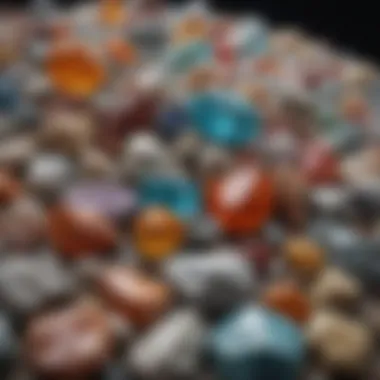

When it comes to bulk crystal rocks, quartz is often a front-runner. A crowning glory in the mineral family, this crystal presents itself in numerous forms and shades. Ranging from clear, milky, to amethyst hues, quartz showcases an impressive diversity.
One of its most notable characteristics is its hardness. On the Mohs scale, quartz ranks at 7, making it relatively durable. This hardness not only enhances its appeal for collectors but also speaks to its utility in various applications. Additionally, the different varieties of quartz, like citrine and rose quartz, attract enthusiasts for their distinct colors and metaphysical properties. However, the variability can also lead to confusion; not all types are suitable for every application.
Uses in Industry
Moving beyond aesthetics, quartz holds a vital role in many industries. Its key characteristic as a piezoelectric material makes it pivotal in electronics. Quartz's ability to generate an electric current when mechanically stressed underlines its importance in devices ranging from watches to smartphones.
Another unique feature of quartz is its thermal stability, which allows it to be used in high-temperature applications. Yet, while quartz's durability is advantageous, it's worth noting that processing it can be energy-intensive, posing environmental concerns.
Feldspar
Occurrence and Significance
Feldspar, the unsung hero in many geological discussions, is actually the most abundant group of minerals in the Earth's crust. What makes feldspar remarkable is its significance in shaping various geological formations. It's often found as a primary constituent in igneous rocks like granite.
The sheer volume of feldspar in nature highlights its beneficial role in providing insights into Earth’s history and processes. Unlike quartz, feldspar can sometimes go unnoticed due to its more subdued colors. However, this doesn't detract from its importance in both academic and practical settings.
Role in Ceramics and Glass
One of feldspar's most notable applications lies in the production of ceramics and glass. As a flux, it lowers the melting temperature of raw materials, facilitating fusion during manufacturing. This key characteristic not only reduces energy consumption but also enhances the overall quality of the finished product.
A unique aspect of feldspar in these industries is its ability to be combined with other materials, allowing for varied textures and finishes in ceramic products. That being said, feldspar can sometimes lead to issues with crazing, which is a concern for manufacturers aiming for high-quality outputs.
Mica
Types and Structure
Mica is yet another fascinating type of bulk crystal rock, known for its unique structure. The thin, flaky layers are instantly recognizable. With varieties including muscovite and biotite, mica’s key characteristic is its ability to be split into very thin sheets, making it quite versatile.
This crystalline structure is a double-edged sword; it allows for fascinating applications in laminate designs but can also complicate extraction and processing. Collectors are often drawn to mica because of its shimmering appearance, especially in well-formed specimens.
Applications in Electronics
Finally, mica finds its niche in the electronics industry, where it serves various purposes, particularly as an insulator. The key characteristic here is its resistance to heat and electricity, which makes it suitable for use in capacitors and other electrical components.
One notable feature is that mica can perform admirably under high temperatures, making it a preferred material in demanding conditions. However, its relative fragility must be considered, as overhandling can lead to breakage, thereby complicating its application and collection.
"Understanding the common types of bulk crystal rocks not only enhances your appreciation but also informs practical application in various fields."
Properties of Bulk Crystal Rocks
Understanding the properties of bulk crystal rocks is essential for both geological study and practical applications. These properties influence their uses across various industries and guide collectors in their pursuits. Knowing what characteristics define a bulk crystal can help enthusiasts appreciate their uniqueness while informing buyers about quality standards.
Physical Properties
Physical properties play a pivotal role in how these crystals are utilized in everything from technology to construction.
Hardness and Cleavage
Hardness is a measure of a mineral's resistance to scratching. The Mohs scale, running from talc (1) to diamond (10), helps determine a crystal's durability. For instance, quartz, rated at 7, showcases excellent hardness which makes it popular in jewelry and construction. The ability to withstand wear and tear is vital for any material.
Cleavage, on the other hand, refers to how a crystal breaks when subjected to stress. Some crystals, like mica, cleave into thin sheets. This property is crucial for applications where specific shapes or forms are needed. Understanding both the hardness and cleavage of these minerals allows collectors and industries to select the right materials for their needs.
"Choosing bulk crystal rocks is much like selecting a tool; it hinges on knowing the strengths and weaknesses of each type."
Transparency and Color Variations
Transparency levels in bulk crystal rocks vary widely, influencing their aesthetic appeal and applications. Clear quartz, for example, is prized for its clarity, making it a favorite in decorative art and healing practices. Conversely, opaque stones can serve functional needs; for example, certain types of feldspar absorb light, which is advantageous in ceramics.
Color variations are another fascinating aspect. Crystals can come in hues ranging from amethyst purple to citrine yellow. The causes of these colors often relate to impurities within the crystal structure or specific environmental conditions during formation. Collectors need to appreciate these variations since they can significantly impact both the value and desirability of a specimen.
Chemical Properties
Chemical properties reveal the composition of bulk crystal rocks, offering insight into their stability and how they react with their surroundings.
Composition and Stability


The composition of a crystal, defined by its mineral constituents, directly impacts its stability. For instance, the presence of iron in quartz may alter its properties, making it susceptible to weathering. An understanding of mineral composition allows collectors and industries to predict how long a crystal will last under certain conditions, making it a huge benefit when considering long-term use.
By knowing the stability factors, enthusiasts can also make informed decisions about how to store and display their collections to avoid degradation over time. It’s important to appreciate that while beautiful, not all crystals have the same longevity.
Reactivity with Other Elements
Reactivity is essential when considering how a bulk crystal interacts with various elements. Some crystals, like those containing iron, may oxidize when exposed to moisture and air. This reactivity can change the physical and chemical parameters of the crystal over time.
On the flip side, this aspect can lead to fascinating transformations, such as the color change in certain minerals when exposed to heat or light. For collectors, understanding reactivity helps in the preservation of specimens. It also informs potential industrial applications, where specific chemical reactions can be beneficial or problematic.
In essence, the exploration of both physical and chemical properties of bulk crystals helps rock and fossil collectors not only enhance their collections but also employ these magnificent minerals in practical yet innovative ways.
Industrial Applications of Bulk Crystals
The study of bulk crystal rocks extends beyond mere fascination; these natural formations play a vital role in various industries. Understanding their industrial applications helps to appreciate their significance in modern technology and construction. Bulk crystals provide not only essential materials but also innovative solutions to complex problems across diverse fields.
Use in Technology
Electronics and Computing
Bulk crystals are fundamental to the world of electronics and computing. In particular, silicon crystals form the backbone of the semiconductor industry. Their ability to conduct electricity efficiently allows for the development of smaller, faster, and more reliable electronic devices. The crystalline structure contributes to the predictability of electrical behavior, making silicon a cornerstone material for everything from smartphones to supercomputers.
One key characteristic of silicon is its high purity level, which is essential for reducing electrical noise in circuits. This property is immensely beneficial, as it enhances signal integrity, enabling clearer data transmission. A unique feature is the process of doping, where small amounts of other elements are introduced to modify its electrical properties, tailoring the material for specific applications.
However, it is essential to note the limitations as well. The dependence on silicon has spurred ongoing research into alternative materials, leading to innovations but also challenges in integration and scalability.
Optical Devices
Optical devices leverage bulk crystals for their ability to manipulate light. Crystals like quartz and calcite are used in various applications, including lenses, prisms, and filters. These materials are renowned for their transparency and optical clarity, making them favorable choices for precision instruments such as cameras and telescopes.
What sets optical devices apart is how they can polarize, disperse, or focus light, enhancing imaging capabilities significantly. For instance, birefringent crystals are crafted into specialized filters that help minimize glare or enhance color contrast in optical systems.
Nevertheless, the intrinsic brittleness of many bulk crystals can be a disadvantage; they may shatter under stress or improper handling. This characteristic demands rigorous manufacturing conditions to ensure durability and functionality.
Role in Construction
Construction is another significant domain where bulk crystals find their applications. Their physical properties contribute to both structural integrity and aesthetic appeal, bridging functionality with design.
Aggregates in Concrete
Bulk crystals often serve as aggregates in concrete, enhancing its strength and durability. Crushed quartz, granite, and limestone are commonly mixed into concrete formulations to provide essential dimensional stability. One of the standout features of these aggregates is their compressive strength, contributing to the overall sturdiness of concrete structures.
This use in construction is notably beneficial due to not only their strength but also their availability in various locations, making them cheaper options for builders. Yet, a downside is that poor grading of these aggregates can lead to inconsistencies in the concrete’s performance, necessitating careful selection and testing.
Decorative Stone
Decorative stones, another application of bulk crystals, find place in architecture and interior design. Rocks like marble and granite are celebrated for their natural beauty and are commonly used in countertops, flooring, and facades. Their unique patterns and colors provide endless choices for designers and homeowners alike, enhancing aesthetic appeal.
The advantage here lies in their durability and ability to withstand wear and tear, making them long-lasting features in both residential and commercial spaces. However, the cost can become a hurdle, especially with high-end stones like rare marble varieties, which can significantly increase project budgets.
Collecting Bulk Crystal Rocks
Collecting bulk crystal rocks is an exhilarating journey that opens up a world of geological wonders. The sheer variety of specimens you can find makes this a captivating hobby. The thrill of discovery, the joy of holding a piece of the Earth's history, and the knowledge gained about their origins all contribute to its allure.
Identifying Quality Specimens
When it comes to collecting, the ability to identify quality specimens can make or break your enthusiasm. A great piece isn’t just beautiful; it’s also authentic and has the potential to appreciate in value over time.
Assessment Techniques
Assessment techniques are crucial when you aim to identify quality specimens in your collection. One primary method includes examining the crystal's surface for blemishes or fractures, which can greatly affect its value. Moreover, utilizing a loupe can enhance your inspection of fine details that may not catch the naked eye, such as the clarity of the mineral or the richness of its color.
A key characteristic of assessment techniques is their objectivity, allowing collectors to apply a consistent standard when evaluating their finds. This promotes a sound decision-making process, minimizing emotional biases that might otherwise cloud judgment. However, this approach might also exclude some unique specimens that could have imperfections but tell a rich geological story.
Common Pitfalls to Avoid
While navigating the world of crystal collecting, it's essential to be aware of common pitfalls. One classic mistake is getting swayed by flashy marketing—just because a seller touts a piece as "rare" doesn’t mean it holds true value.
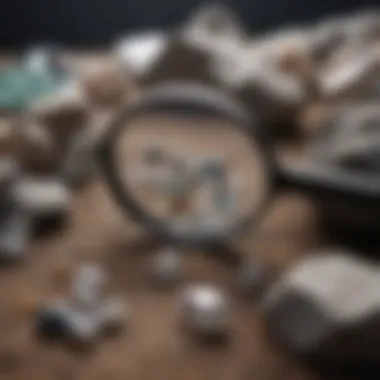
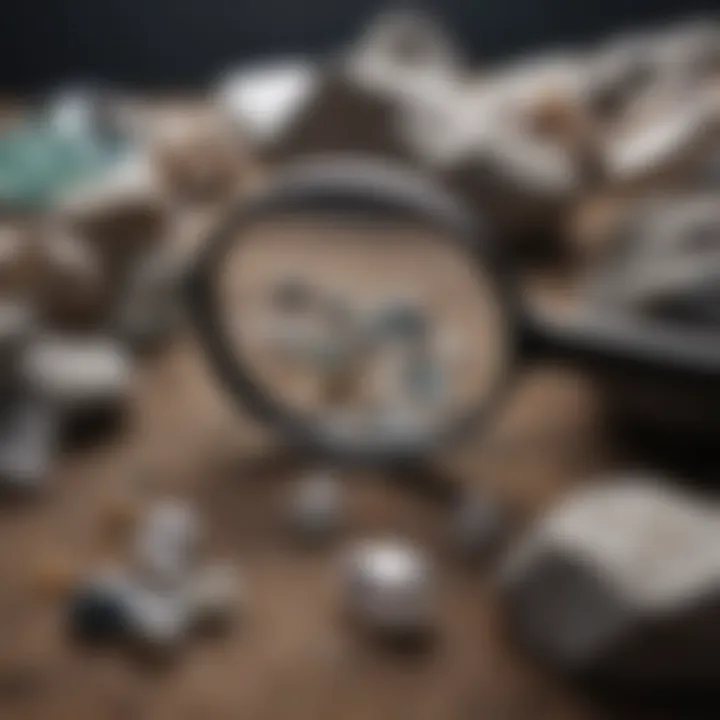
A notorious characteristic of these pitfalls is their tendency to lure collectors into dubious transactions. Educating oneself about the specific mineral’s market value can be your lifeline here. Still, there’s a downside; becoming overly analytical can sometimes take away from the joy of collecting, forcing you to see everything through a critical lens instead of savoring the beauty of your finds.
Sourcing and Where to Buy
Finding the right sources for acquiring bulk crystal rocks is another nuanced aspect of this hobby. Each avenue comes with its own set of advantages and disadvantages.
Mineral Shows and Fairs
Mineral shows and fairs are treasure troves where collectors can meet suppliers and enthusiasts alike. The benefit here lies not just in direct purchases but also in the wealth of knowledge from interacting with experienced collectors and vendors. You might stumble upon rare finds or gems at a bargain price—or hear fascinating stories behind certain specimens.
However, one must also be cautious as prices can fluctuate widely based on the seller and the event's popularity. Being prepared to negotiate is essential, but so is being aware of what constitutes a fair price for the specific rock you’re interested in.
Online Marketplaces
Online marketplaces have transformed the way collectors source their items. Websites like eBay, Etsy, and specialty mineral shops can provide access to a global range of crystals, often at competitive prices. The conveniences of home shopping and the ability to filter searches according to your preferences make online platforms particularly attractive.
Nevertheless, the downside is that you lose the tactile experience of examining the rocks before purchasing. You may encounter misrepresented items that look better in photos than in real life. To mitigate this, always scrutinize seller ratings and read customer reviews. Having a trusted reputation in online transactions matters immensely.
Caring for Bulk Crystal Collections
Caring for bulk crystal collections is crucial for any serious enthusiast or collector. These geological treasures offer not just aesthetic value but also historical and educational insights. Proper care can preserve their natural beauty, maintain their structural integrity, and enhance their value over time. When collecting these specimens, individuals often overlook how proper maintenance can significantly contribute to their enjoyment and the longevity of their collection.
Storage Techniques
Display vs. Storage
When considering how to display or store bulk crystal collections, collectors face an important decision. Displaying crystals can bring a personal touch to a living space, showcasing the collector's passion and knowledge. Many choose display options such as glass cases or open shelves, allowing natural light to illuminate these gems. However, there lies a downside; exposure to too much light can cause some minerals to fade or degrade. On the other hand, storaging crystals in more concealed settings—like padded boxes or drawers—can protect them from potential damage caused by dust, physical contact, or environmental changes. One specific advantage of storage is minimizing the risk of mishaps, such as accidental drops that could chip or crack the crystal.
On the flip side, keeping crystals in storage often means losing the visual pleasure they provide. Ultimately, the decision between display and storage should weigh factors like the collector's environment, the types of crystals owned, and how often they want to engage with these pieces.
Preventative Measures
Implementing preventative measures is another key component of caring for bulk crystal collections. This encompasses practices aimed at protecting crystals before potential damage occurs. A fundamental aspect of preventative care is monitoring the environmental conditions where the crystals are kept. Avoiding extreme temperatures, humidity, and direct sunlight can make a world of difference in preserving the integrity of the specimens. Utilizing silica gel packets in storage compartments can help absorb excess moisture, fostering a stable environment that deters mold and degradation.
Collectors should also consider proper handling techniques; wearing gloves while touching delicate crystals can prevent oils from the skin from tarnishing or damaging the surface. Using padded materials to separate each specimen during storage can minimize friction and the risk of scratches. While these preventative measures might seem cumbersome at first, the benefits—such as longevity and maintained aesthetics—far outweigh the initial effort.
Cleaning and Maintenance
Best Practices
When it comes to maintaining bulk crystal collections, knowing best practices for cleaning is essential. Cleaning helps prevent the accumulation of dust, dirt, or residues that could tarnish the crystals over time. A recommended approach is to use a soft-bristle brush for dry cleaning. Dust can easily be brushed away without risking scratches on the surface of the specimens. For those that require slightly more than just dusting, lukewarm water with a mild soap can effectively clean without being too harsh.
A key characteristic of best practices is using the least invasive methods possible—keeping cleaning routines simple helps maintain the crystals’ natural features, avoiding damage incurred from aggressive scrubbing or the use of harsh chemicals. Another important point to keep in mind is maintaining a cleaning frequency that is neither too infrequent nor overly obsessive. Finding that balance is vital in ensuring the crystals remain stunning and authentic.
Common Cleaning Agents
The choice of cleaning agents can be a double-edged sword in caring for bulk crystal collections. Many collectors might be tempted to reach for common household cleaners. However, this can be a mistake, as certain chemicals may react adversely with specific minerals. Choosing safe cleaning agents like mild dish soap mixed with water or specialized mineral cleaning products can prevent unwanted reactions.
Furthermore, natural options like vinegar and baking soda can work wonders for loosening dirt without harming the integrity of the crystals. While effective, it's important to test any cleaner on a small, inconspicuous area before applying it more broadly. The unique advantage of common cleaning agents is often their widespread availability and ease of use, allowing collectors to maintain their crystals without extensive preparations or searching for niche products.
Proper care for bulk crystal collections ensures that every piece retains its beauty and value, turning your passion into a worthwhile long-term journey.
Closure: The Intricacies of Bulk Crystal Rocks
In wrapping up our adventure through the world of bulk crystal rocks, it’s vital to reflect upon the multi-faceted role these geological treasures play. They are not merely beautiful adornments; they hold scientific, industrial, and personal value that can resonate deeply with collectors and enthusiasts alike. Understanding the intricate properties and vast applications of these crystals urges us to appreciate their presence in both our daily lives and the broader tapestry of Earth’s geological narrative.
Reflecting on Their Value
When one thinks about bulk crystal rocks, often it is the visual appeal that draws attention first. However, there’s much more beneath the surface. Beyond aesthetics, these minerals serve foundational roles across various industries. For instance, quartz, which is ubiquitous in the collection sphere, is essential for making glass and electronics. Its abundance and versatility provide a practical lens through which one can view the significance of crystal rocks not just in isolation, but as contributors to everyday technology.
Furthermore, in the realm of geology, the study of these crystals offers insight into the Earth’s history. Each mineral tells a story, revealing clues about the conditions under which it formed. By analyzing these rocks, geologists can decipher volcanic activity, sedimentary processes, and shifts in the Earth’s crust over millennia. This intrinsic relationship between bulk crystal rocks and Earth’s heritage underlines their global significance, calling for both serious study and appreciation.
“The true beauty of bulk crystal rocks lies not only in their physical form but also in the stories they tell about our planet’s past.”
Encouragement to Explore
As we close this discussion, the invitation to explore remains wide open. Whether you’re just dipping your toes into the world of rock collecting or are a seasoned veteran, there’s always more to uncover. The beauty of collecting bulk crystal rocks extends beyond acquisition; it is about the thrill of discovery, the joy of sharing, and the satisfaction of understanding.
Visit mineral shows or local fairs to engage with fellow collectors and learn firsthand about diverse specimens. Online avenues like Reddit have communities brimming with enthusiasts ready to share their insights and experiences. Each rock has a tale to tell, and participating in these communities can enrich your understanding immensely.
In your exploration, consider adopting a thoughtful approach. Not only should you focus on the aesthetic elements of the crystals you collect, but also on their origins and significance. Each piece could very well be a window into Earth’s complex and ever-evolving story.
Ultimately, the world of bulk crystal rocks is an ongoing journey. It thrives on curiosity, community, and the ever-deepening appreciation we cultivate for the materials that form our planet. So grab your tools, step outside, and let the search for your next great find lead you to unforeseen wonders.



